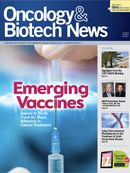Publication
Article
Oncology & Biotech News
Digoxin Found to Be Effective in the Fight Against Prostate Cancer
Author(s):
A search for potential chemopreventive agents for prostate cancer uncovered an unlikely candidate in digoxin, one of the oldest drugs for cardiovascular disorders

Elizabeth Platz, ScD, MPH
A search for potential chemopreventive agents for prostate cancer uncovered an unlikely candidate in digoxin, one of the oldest drugs for cardiovascular disorders. Men with a history of digoxin therapy had a 24% reduction in the risk of prostate cancer. Although only 2% of men in a large cohort study were taking digoxin, the findings support the value on “therapeutic repositioning,” which is the therapeutic equivalent of teaching an old dog new tricks.
“Drugs that are already available, especially drugs with a long history of use like digoxin, have accumulated a large volume of safety research, which might not have to be repeated,” said Elizabeth Platz, ScD, MPH, a professor of epidemiology at Johns Hopkins University, in an interview at the AACR meeting in Orlando, Florida. “In many cases, we can begin clinical evaluation more quickly as compared with a new drug that has to prove it can be used safely in humans.”
Digoxin’s emergence as a potential chemopreventive agent began with its inclusion among almost 3200 drugs screened for anticancer activity in a therapeutic repositioning program. Digoxin demonstrated the most potential to kill prostate cancer cells by achieving an inhibitory concentration (IC50) of 163 nM. The second-best inhibitor was the antiarrhythmic drug lanatoside, which had an IC50 of 408 nM, well behind that of digoxin.
In a second phase of investigation, Platz and colleagues analyzed data on 48,000 men who participated in the Health Professionals Follow-up Study from 1986 to 2006. The analysis showed that 2% of the men were taking digoxin at baseline. As compared with nonusers, men who used digoxin had a 26% lower risk of prostate cancer after adjustment for age and a 24% lower risk in a multivariate analysis.
The magnitude of the benefit increased with the duration of digoxin use. Men who used digoxin for less than 5 years or for 5 to 10 years risk reductions of 15% to 16% compared with those who have never used it—differences that did not achieve statistical significance. Prostate cancer risk declined dramatically by 46% to 47% in men who reported using the drug for ≥10 years.
Trend analysis confirmed a significant inverse relationship between duration of digoxin use and the risk of prostate cancer (P <.001). Though encouraging, the findings require cautious interpretation, said Platz. The results do not prove that digoxin prevents prostate cancer. Additionally, the drug has considerable side effects that preclude its use in healthy people.










